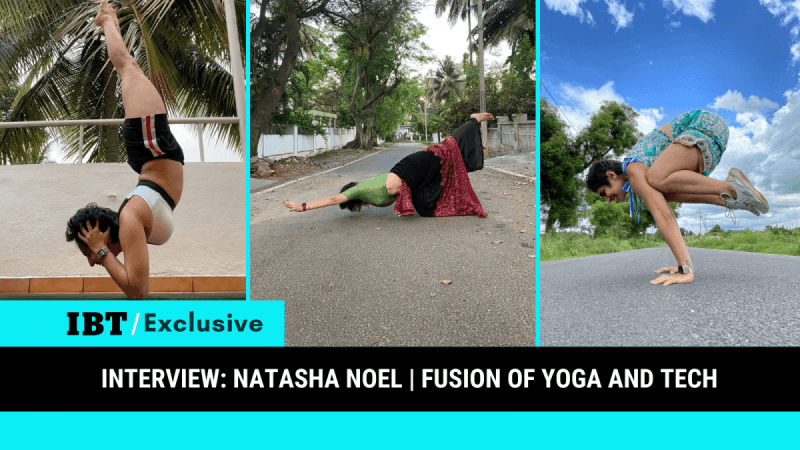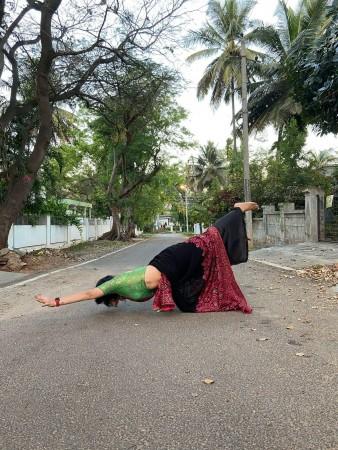
As the world gears up to celebrate International Yoga Day on June 21, there are many inspiring stories of how yoga has changed many lives for the better. One such story is that of Natasha Noel, a renowned figure in the realm of yoga, dance, and social media influence. Natasha has garnered a massive following on platforms like YouTube and Instagram, where she seamlessly blends her passion for yoga with creative self-expression. Beyond her online presence, Natasha's journey is marked by resilience, having overcome challenges such as a career-ending knee injury and dyslexia.
On the occasion of International Yoga Day, Natasha shares how yoga not only transformed her life but continues to inspire millions worldwide. Embracing the holistic benefits of yoga, Natasha reflects on its profound impact on her mental well-being, self-acceptance, and physical vitality. She also sheds light on her unique approach to integrating dance into yoga practice, creating a harmonious balance between strength and grace.
In this exclusive interview with International Business Times, Natasha Noel discusses the role of yoga in fostering self-love and emotional resilience, especially for those facing similar challenges. She also explores the evolving landscape of yoga in the digital age and the use of wearable technology like the Apple Watch to enhance mindfulness and track workout progress.
Below are edited excerpts from our interview with Natasha Noel:
IBT: Millions follow your yoga journey on social media. Can you tell us a little about how yoga entered your life?
Natasha Noel: I actually had a really bad knee injury, and the doctors told me if I continued dancing, I wouldn't be able to walk. So I had to stop being a professional dancer. Almost 6 months later, I downloaded Instagram and I saw these beautiful and strong pictures of women doing yoga and I said, Wow, I want to try that. So I initially YouTubed the physical asanas, bought books and loved the philosophy of yoga. And not only did it help me physically but mentally, I was a much better person. And then, 2 months later, I did my first teacher training course and multiple after that.
IBT: When did you discover the power of yoga, and how has it helped you on and off the mat?
Natasha: I think first time I felt the power of yoga was when my mental health was better. When I started learning to believe in myself, and was actually okay with me. The whole quirk and all. It's made me accept a lot of my past, forgive myself and truly let it go. You're just detached from most of the things you can't control or blame. And most of the yogic philosophy talks about detachment and through meditation, you can achieve it.
Also, off the mat, my anger has reduced substantially. Not all is gone, but that's also part of being human. On the mat, the fact that my body now can do so many things but also humbled me when I've gotten injuries to be patient with myself and trust myself for getting better.
IBT: You're a talented dancer! How does your love for dance translate into your yoga practice, or vice versa?
Natasha: So yoga is more static and even if you're doing a vinyasa (flow), the movement is not fluid; it's a strong practice. Whereas the dance I do is much more fluid, I just merged the two, and voila, yoga dance was created.
IBT: Many people use wearable technology like the Apple Watch to track their workouts. As a yoga instructor, what are your thoughts on using the Apple Watch for yoga practice?
Natasha: Honestly, I love tracking my practice with the Apple Watch. It helps keep me motivated and accountable, since a little chart on my phone pops up that tells me how often I'm practicing.
So the Apple Watch will notify you if something is very irregular, like your heartbeat, or if you are exposed to too much sound. So even though a high heart rate is an indicator of exertion, you can get that while climbing the stairs or running to catch a bus. However, my advice is that when you are practicing yoga, you don't need to check every minute how your rates are; instead, after practice, you can use it as a guideline to check if things are okay. Or how you can improve your breathing while in the practice so your heart rate becomes lower.

IBT: Are there any features you find particularly useful for yoga?
Natasha: For instance, some Apple Watches offer guided breathing exercises. Yes, breath work is good but in the Mindfullness app, there is a section on reflection that's my absolute favourite. It'll give you a theme and you just reflect on it by focusing your attention. And every time after you feel content because you're recalling moments that feel good, like recalling when you had a sense of purpose, the moment you were happiest or thinking of someone with kindness and continuing on with that kindness for the rest of the day. It truly makes you pause and reflect when you are either having a busy day or hating the day but after the departure, you feel so much more at ease.
IBT: Your Instagram is a beautiful space for self-love and self-expression. How has yoga impacted your relationship with your body and overall well-being?
Natasha: Like I said before, yoga has helped me accept a lot of things. One more thing was my body. This is who I am, yes. Can we get better? Yes. Do we need to hate ourselves in the process? Hell no!
IBT: We know you were diagnosed with dyslexia. Did yoga play a role in overcoming challenges related to learning or self-confidence?
Natasha: Honestly, before I was diagnosed, I always felt dumb and stupid. After I was diagnosed, it was a huge weight that was lifted off my chest, but the 20 years of negative self talk was still ingrained in me. That was hard. And I would also get severe anxiety attacks, which I thought were Asthama attacks and no matter how much I took the pump, it wouldn't soothe the not being able to breathe part because of life and past trauma, not just the dyslexia. But Pranayama to the rescue. Not only did my astama just vanish, but my anxiety attacks are almost non-existent now.
Also, any moment I feel just a sudden urge of tightness in my chest, I pause whatever I'm doing, open the mindfulness app on the Apple Watch and breathe along as shown. And feel the tightness disappear within seconds. My confidence improved because my anxiety reduced. That made me look at my mental health and body differently.

IBT: Looking ahead, what are your hopes for promoting yoga and self-acceptance, especially for young people facing similar challenges?
Natasha: I want children to start learning, whether it's learning to sit quietly and move your bodies. Eventually, those kids will grow up being much more internally fulfilled, with better regulation of emotions and a higher EQ. You will then automatically feel more confident.
As for people struggling with it, you can start with BASIC yoga classes online and see which style you like. Find a teacher teaching that agile and learning under them. Books you can read in the process are
1. Light on Yoga by BKS Iyengar
2. Asana Pranamayam Mudra Bandha by Swami Satyananda Saraswati
3. Autobiography of a Yogi by Paramahansa Yogananda.
4. Yoga Anatomy, Second Edition, by Leslie Kaminoff and Amy Matthews. (If you're an anatomy nerd like me.)
IBT: Finally, with International Yoga Day upon us, do you have a special message or practice routine you'd like to share with our readers?
Natasha: To anyone starting their yoga journey or seeking solace, remember that progress comes with patience and self-compassion. Begin with a few mindful breaths and gradually build your practice. Whether it's through gentle asanas or a more vigorous routine, let yoga guide you towards inner peace and physical vitality.














